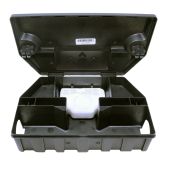Rat Bait Stations

When baiting for rodents the top priority should be the safety of people and pets. The challenge is to allow the rodents to get to, and eat, the bait without allowing children and pets to have access to it. Tamper-resistant rat bait stations offer a simple and economical solution to this problem.
Click Here: Rat Baits
Click Here: Rat Bait Station Advantages
Top Recommendations
Low Profile and Realistic
Bait Stations (Bait Included)
-
-
-
-
-
-
-
-
-
-
- JT Eaton Rodent Rock 2G with Paver (Tamper - Resistant Bait Station)
Starting at $28.50
Out of stock -
-
Rat Bait Station Advantages
Protects Children and Pets From Poison Rodent Baits
Placing the rodent bait blox onto the rods or pegs inside the bait station will permit the rat to feed, but not remove the bait (translocate) to another location. This protects children and non targeted animals from the poison bait.
Keeps Rodent Bait Fresh
In addition to protecting non-targeted animals from the poison bait, tamper-resistant rat bait stations also protect the inserted bait from the weather. The bait stations will keep the bait fresh. Fresh bait attracts the rodent for a longer time period.
Rodent Bait Stations with Rods
Securing the bait on the bait rods will ensure that the rodents can not remove the bait. They will eat the bait inside the bait station. Besides not translocating the bait, rodent bait stations will stop one rat from hoarding the bait, permitting all the rat colony to feed on it.
Rat Bait Station Placement Tips
Rod the bait inside the bait stations. Set the rat bait stations between 15-50 feet apart. If the rat population is heavy, go about every 15 feet. Inspect for harborage areas, and place bait stations near these areas.
Rats are suspicious of new objects in the environment. Norway rats and Roof rats may need some encouragement to enter the rat bait stations for the first time. This problem is solved by placing a non toxic lure like peanut butter, fish or apples just inside the entrance holes. It is crucial not to allow the rodenticide to touch the lure.
- Place rat bait stations near runways where rats will most likely find them. For Norway rats, the placement is typically on the ground. For Roof rats, the rat station location is a higher placement.
- Keep the rat bait stations filled with rat bait, until the rat population is killed. Empty stations mean missed opportunities to totally kill the population.
- When two or more consecutive rat bait stations show signs of feeding, add more stations in between to make sure that the rodents are not entering the adjacent structure.
- If you are performing commercial rodent control around food facilities, become knowledgeable of sanitation procedures.


















